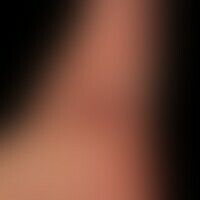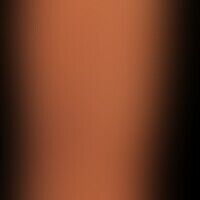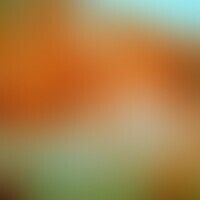
Necrobiosis lipoidica L92.1
Necrobiosis lipoidica: detailed picture with pronounced atrophy of the surface epithelium.
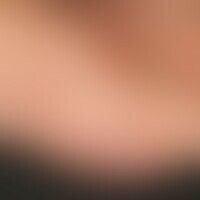
Larva migrans B76.9
Larva migrans. general view: Acutely occurring, itchy, dynamically increasing, linear, firm, livid red plaque on the right back of the foot, existing since 3 weeks, after a beach holiday in Thailand.
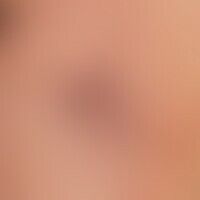
Varice reticular I83.91

Henoch-Schoenlein purpura D69.0
Purpura Schönlein-Henoch. seeding of smallest petechiae beside fresh and older haemorrhagic maculae.

Pemphigoid bullous L12.0
Pemphigoid bullous: clinical picture that was mainly impressive due to its excessive itching; skin changes rather discreet.

Atrophy of the skin (overview)
Atrophy of the skin due to many years of internal use of glucocorticoids. Bizarre scars due to tearing of the skin after banal abrasions.

Acroangiodermatitis I87.2
Acroangiodermatitis. detail from the above figure. 0.2-0.4 cm large, initially isolated, then aggregated, deep red to reddish-livid papules develop from the smallest red (haemorrhagic) spots with a smooth surface, which finally confluent to form large plaques.

Vasculitis leukocytoclastic (non-iga-associated) D69.0; M31.0
Vasculitis, leukocytoclastic (non-IgA-associated). multiple, acute, symmetric, since 2 weeks existing, localized on both lower legs, irregularly distributed, 0.1-0.2 cm large, sharply defined, symptomless, hemorrhagic spots and blisters as well as beginning incrustations.

Larva migrans B76.9
Larva migrans. linear plaque, subepidermally situated, tortuous, constantly itching gait on the right hollow foot. conspicuously in the area of the gait structures described blister formation.
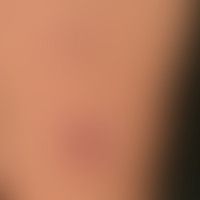
Sarcoidosis of the skin D86.3
Sarcoidosis, subcutaneous nodular form:known pulmonary sarcoidosis; skin findings: subcutaneously and cutaneously located nodules and plates which can be easily distinguished from the surrounding area and which slide on the support.

Fasciitis necrotizing M72.6

Papillomatosis cutis lymphostatica I89.0
Papillomatosis cutis lymphostatica:large-area, distally sharply defined, proximally tapering, coarsely indurated, large-area, verrucous plaque with smaller nodules; condition following recurrent erysipelas.

Necrobiosis lipoidica L92.1
Necrobiosis lipoidica: Discrete finding with slightly hardened plaque and atrophic surface (parchment-like puckering of the skin surface in the centre).

Pyoderma gangraenosum L88
Pyoderma gangraenosum. multiple, chronically progressive, painful, large-area, blue-reddish nodules, partly with polycyclic ulcerations. characteristic is the necrotic ulcer with a painful marginal zone with walllike, undermined margins and dark red, livid erythematous border.

Arterial leg ulcer L98.4
Ulcus cruris arteriosum: Sharply defined, painful ulcer on the back of the foot that seizes the tendon.

Klippel-trénaunay syndrome Q87.2
Klippel-Trénaunay syndrome: extensive vascular malformation with extensive nevus flammeus affecting the trunk, the right arm and both legs. No evidence of soft tissue hypertrophy so far. No AV fistulas.




